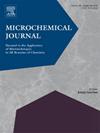Electrochemical sensor based on coordination compound [Co(BDC)]n allows detection of catecholamine neurotransmitter associated with neurological disorder from biological samples
IF 4.9
2区 化学
Q1 CHEMISTRY, ANALYTICAL
引用次数: 0
Abstract
The neurotransmitter dopamine (DA) plays a crucial role as a messenger in the brain and various organs. Assessing DA levels in biological fluids is critical to identifying stress-related disorders, substance abuse, and neurochemical imbalances. Monitoring DA levels in urine and saliva samples is crucial for diagnosing neurological disorders. In this study, we successfully synthesized and confirmed a novel electrochemical sensor based on the coordination compound Cobalt-benzenedicarboxylate, [Co(BDC)], through extensive characterization via Fourier Transform Infrared Spectroscopy (FT-IR), X-ray Diffraction (XRD), Scanning Electron Microscopy with Energy Dispersive X-ray Spectroscopy (SEM-EDS) and Thermogravimetric Analysis (TGA) analyses. Using this material, it was developed an electrochemical sensor ([Co(BDC)]/CPE) for DA detection from biological samples (urine and saliva). After optimizing the main parameters, DA was detected using an electrode modified with 25 % (m/m) [Co(BDC)] in pH 6 solution, with an applied potential increment of 5 mV, a frequency of 75 Hz and a amplitude of 100 mV. The sensor demonstrated satisfactory performance in urine samples with limit of detection (LOD) and limit of quantification (LOQ) of 1.7 μmol/L and 5.7 μmol/L, respectively. In saliva samples, the LOD and LOQ were 0.5 μmol/L and 1.7 μmol/L, respectively, with good linearity (R > 0.9922), indicating a strong linear relationship between analyte concentration and sensor response. Recovery rates between 84.9 % and 97.1 % indicate the reliable accuracy of the modified electrode in detecting DA, with relative standard deviation (RSD) < 8.0 % (n = 3) in complex samples. This method shows potential for practical applications in analyzing real samples contributing for diagnosing neurological diseases associated with this neurotransmitter.基于配位化合物[Co(BDC)]n 的电化学传感器可检测生物样本中与神经紊乱有关的儿茶酚胺神经递质
神经递质多巴胺(DA)在大脑和各种器官中扮演着重要的信使角色。评估生物体液中的多巴胺水平对于确定与压力有关的疾病、药物滥用和神经化学失衡至关重要。监测尿液和唾液样本中的 DA 含量对于诊断神经系统疾病至关重要。在本研究中,我们通过傅立叶变换红外光谱(FT-IR)、X 射线衍射(XRD)、扫描电子显微镜与能量色散 X 射线光谱(SEM-EDS)和热重分析(TGA)分析,成功合成并确认了一种基于配位化合物苯二甲酸钴([Co(BDC)])的新型电化学传感器。利用这种材料开发了一种电化学传感器([Co(BDC)]/CPE),用于从生物样品(尿液和唾液)中检测 DA。在对主要参数进行优化后,在 pH 值为 6 的溶液中使用 25% (m/m) [Co(BDC)]修饰的电极检测 DA,施加的电位增量为 5 mV,频率为 75 Hz,振幅为 100 mV。该传感器在尿液样本中的性能令人满意,检测限(LOD)和定量限(LOQ)分别为 1.7 μmol/L 和 5.7 μmol/L。在唾液样品中,检测限和定量限分别为 0.5 μmol/L 和 1.7 μmol/L,线性关系良好(R > 0.9922),表明分析物浓度与传感器响应之间具有很强的线性关系。回收率在 84.9 % 和 97.1 % 之间,表明改良电极在检测 DA 方面具有可靠的准确性,在复杂样品中的相对标准偏差(RSD)小于 8.0 %(n = 3)。这种方法显示出在实际应用中的潜力,有助于分析真实样本,诊断与这种神经递质有关的神经系统疾病。
本文章由计算机程序翻译,如有差异,请以英文原文为准。
求助全文
约1分钟内获得全文
求助全文
来源期刊

Microchemical Journal
化学-分析化学
CiteScore
8.70
自引率
8.30%
发文量
1131
审稿时长
1.9 months
期刊介绍:
The Microchemical Journal is a peer reviewed journal devoted to all aspects and phases of analytical chemistry and chemical analysis. The Microchemical Journal publishes articles which are at the forefront of modern analytical chemistry and cover innovations in the techniques to the finest possible limits. This includes fundamental aspects, instrumentation, new developments, innovative and novel methods and applications including environmental and clinical field.
Traditional classical analytical methods such as spectrophotometry and titrimetry as well as established instrumentation methods such as flame and graphite furnace atomic absorption spectrometry, gas chromatography, and modified glassy or carbon electrode electrochemical methods will be considered, provided they show significant improvements and novelty compared to the established methods.
文献相关原料
| 公司名称 | 产品信息 | 采购帮参考价格 |
|---|
 求助内容:
求助内容: 应助结果提醒方式:
应助结果提醒方式:


